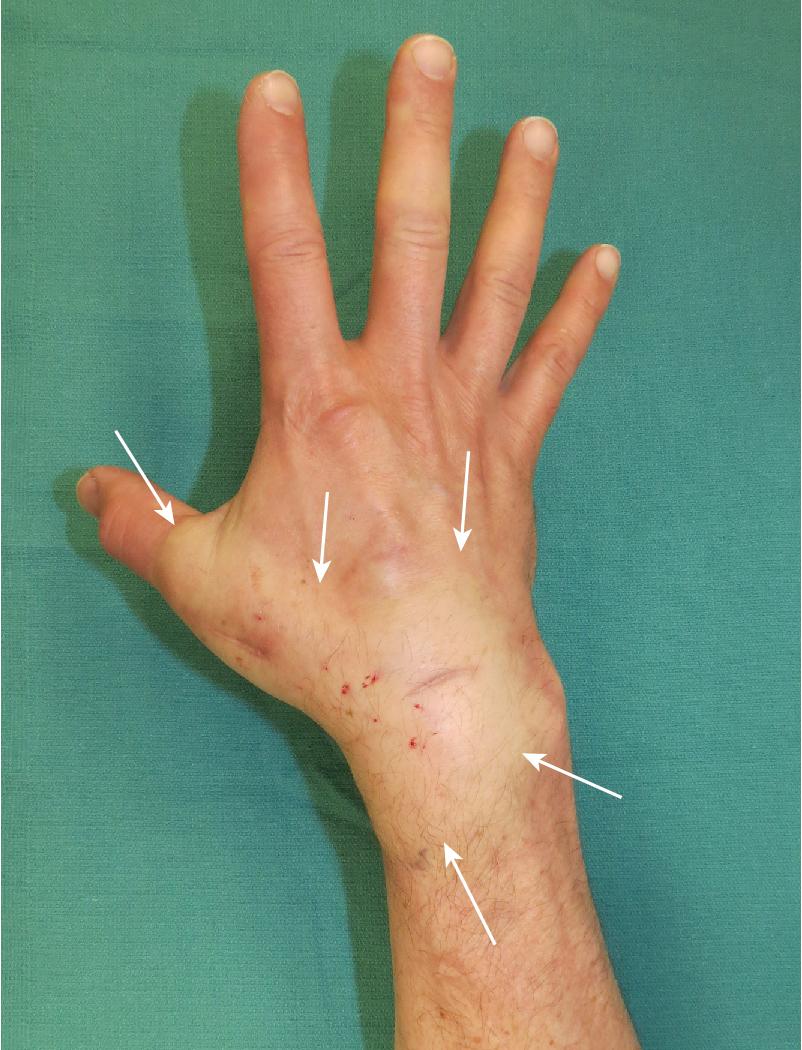Physical Address
304 North Cardinal St.
Dorchester Center, MA 02124
Many, if not all, tendon and nerve conditions can be approached using wide-awake local anesthesia. It is also common for arthritic conditions of the fingers and may be considered for digital fractures as well.
The following are example conditions for which the authors find this technique to be particularly suitable.
Tendon conditions, including primary and secondary tendon repair, single and two-stage tendon reconstruction, tenolysis, trigger finger A1 pulley releases, first dorsal compartment release, sagittal band repair, and tendon transfers.
Nerve conditions, including carpal tunnel release, in-situ ulnar nerve decompression at the cubital tunnel and at the Guyon canal, digital nerve laceration exploration, and primary repair.
Trauma including phalangeal fractures, collateral ligament repair, and contracture release.
Arthritic and other conditions, such as metacarpophalangeal and interphalangeal arthrodesis, metacarpophalangeal joint silicone arthroplasty, and Dupuytren fasciectomy.
Wide-awake surgery with local anesthesia allows for active participation from the patient, which can provide an immediate intraoperative assessment of function, especially for tendon transfers, tenolysis, and contracture releases.
Tension for tendon transfers, repairs, and reconstructions is assessed intraoperatively, after provisional suture fixation. If the connection is too tight or too loose and does not allow for adequate range of motion (ROM), the tension can be adjusted immediately.
The technique spares the patient from systemic anesthetic medications and their complications, including postoperative nausea and vomiting.
Vasoconstriction from epinephrine can eliminate the need for a tourniquet, whose use can cause significant patient discomfort on the upper arm.
Epinephrine should not be used in patients with compromised digital perfusion, including those with severe peripheral vascular disease, chronic renal failure, Buerger disease, scleroderma, and other connective tissue diseases.
The precise nature of hand and wrist surgery requires that the patient be able to keep the arm completely motionless during the procedure, except when directed to test function. Therefore patients who may become too anxious or agitated and cannot reliably follow commands, including children and some patients with developmental delays, are not good candidates for wide-awake local anesthesia.
In addition to the appropriate examination for the patient’s condition, the fingers should be examined for any signs of poor perfusion. Temperature, turgor, color, and capillary refill of the fingertips should be assessed preoperatively.
Specific imaging, such as angiography, is not needed before proceeding with wide-awake surgery, unless the patient has a history of poor digital perfusion.
The patient should always be lying down before injection of local anesthetic in case of a vasovagal response.
Both supine and lateral decubitus positioning is acceptable based on surgeon preference, patient comfort, and the planned procedure.
Ensure that the patient is comfortable before prepping and draping the extremity so they do not need to readjust during the operation.
Even when using epinephrine, a tourniquet can be placed on the arm outside the anticipated operating field, but not inflated, to have as a backup in case emergency hemostasis is needed.
If the procedure is limited to the hand, many patients tolerate a tourniquet on the forearm much more and for longer than on the brachium.
An epinephrine injection may cause patient tremors or a vasovagal reaction. The patient should be lying down before the injection to prevent any injury.
This is the most commonly used local anesthetic for wide-awake surgery because it has a very short onset of action (around 5 minutes) and lasts for 30 to 60 minutes as a local infiltration and around 1 to 2 hours in peripheral nerve blocks. The maximum dose of subcutaneous injectable lidocaine is 7 mg/kg when administered with epinephrine (without the delayed systemic absorption caused by epinephrine-induced vasoconstriction, the maximum dose is 5mg/kg.). Commercial preparations of lidocaine come in 1% or 2% concentrations with and without epinephrine added, but these can be diluted with normal saline if a larger volume is needed.
| Alone (Without Epinephrine) | With Epinephrine | |||
| Anesthetic agent | Maximum Dose | Duration | Maximum Dose | Duration |
| Lidocaine | 4 mg/kg | 30–60 min | 7 mg/kg | 2–3 hours |
| Bupivacaine | 2.5 mg/kg | 2–4 hours | 2.8 mg/kg | 4–12 hours |
| Ropivacaine | 2.8 mg/kg | 2–4 hours | 3.5 mg/kg | 4–12 hours |
For example, a person weighing 70 kg (155 lbs) may receive up to 490 mg of lidocaine, or 49 mL of 1% lidocaine with epinephrine (1:100,000) solution. This can be diluted with 50 mL of normal saline to yield 99 mL of a 0.5% lidocaine with epinephrine (1:200,000) solution or with 150 mL of normal saline to produce 199 mL of 0.25% lidocaine with epinephrine (1:400,000).
These anesthetic agents may be added to lidocaine to prolong the duration of the nerve or field block. Their typical durations of action are 6 to 9 hours of anesthesia, and bupivacaine or ropivacaine should be mixed with lidocaine for procedures that are anticipated to last longer than 3 hours or to aid with postoperative analgesia.
This potent alpha-adrenergic agent causes local vasoconstriction in high doses (1:50,000–1:100,000), which provides hemostasis and a relatively bloodless field to allow for safe surgery without a tourniquet. The hemostatic effect has been shown to take around 26 minutes to reach its maximum. Besides hemostasis, epinephrine provides additional benefits, as detailed in the following sections.
The vasoconstriction from epinephrine slows systemic absorption of the local anesthetics and delays their metabolism and clearance from the operative field. This prolongs their effects and permits a higher maximum dose to be administered.
Although maximal hemostasis does not occur for 26 minutes, an immediate action causes skin blanching, which indicates which skin has been infiltrated and anesthetized ( Fig. 77.1 ).

Become a Clinical Tree membership for Full access and enjoy Unlimited articles
If you are a member. Log in here